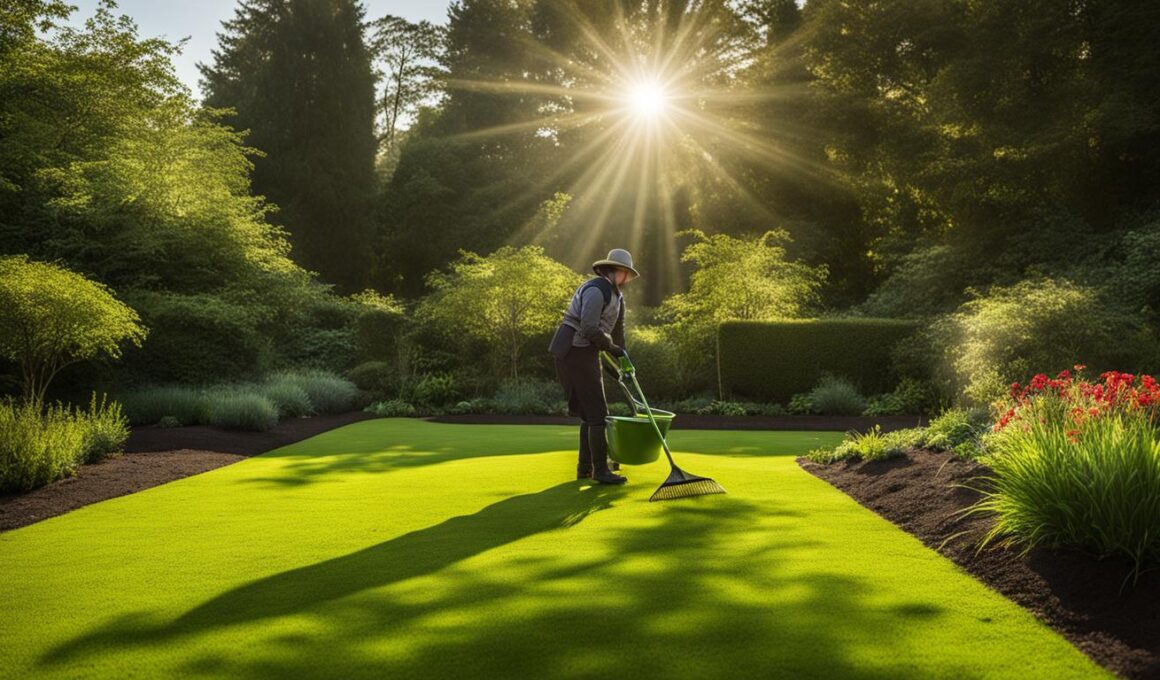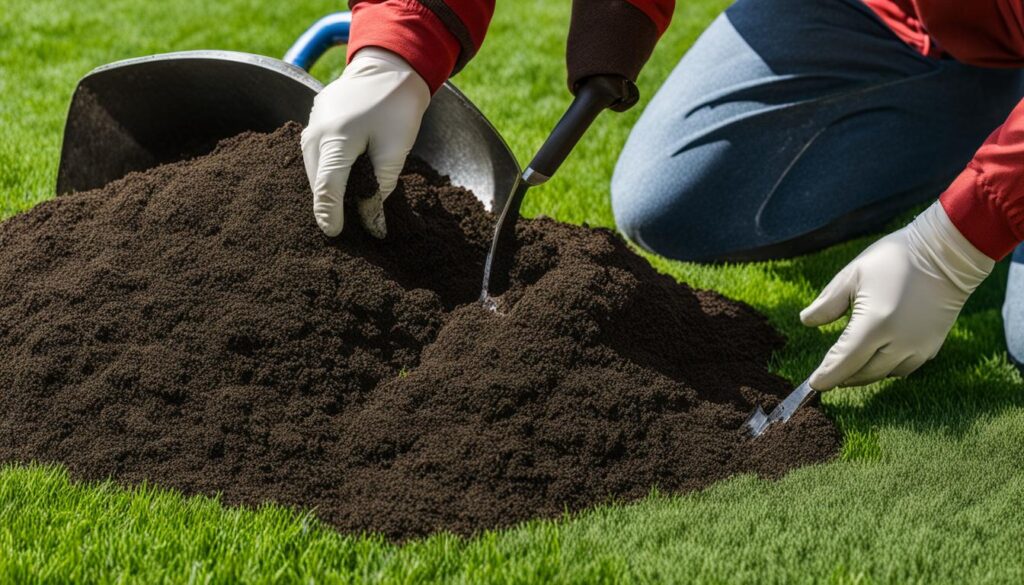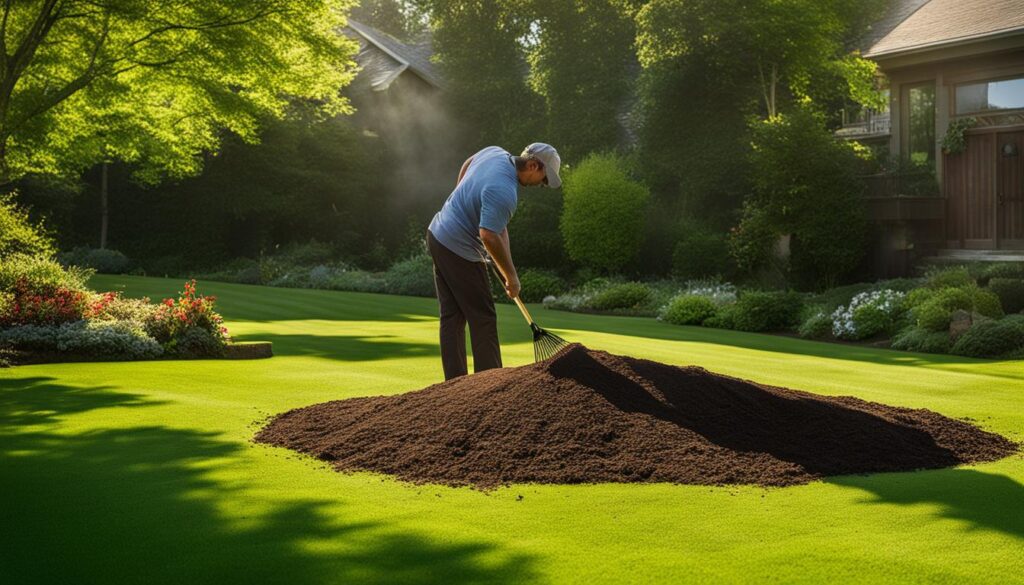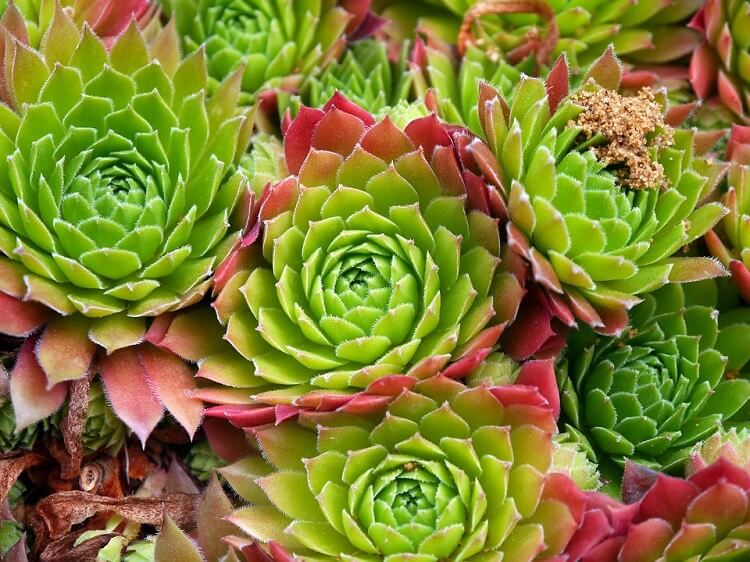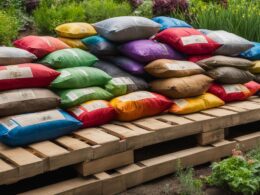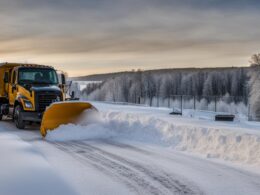Topdressing a lawn involves spreading a thin layer of material, such as compost or sand, over the grass to improve soil quality and promote healthy grass growth. This process has been used in golf courses for many years and is gaining popularity among homeowners transitioning to organic lawn care. Topdressing offers numerous benefits, including adding organic matter to the soil, improving soil structure and water holding capacity, reducing thatch, and reducing the need for fertilizing. It can be done with various materials, such as sand, topsoil, compost, or a custom-blended mix. The choice of material depends on the existing soil type and the specific needs of the lawn. Topdressing can be a DIY project, but it requires labor and can be time-consuming. It is recommended to topdress the lawn regularly or as needed, depending on the specific requirements of the lawn. Topdressing can be combined with other lawn maintenance practices, such as aeration and overseeding, to achieve the best results.
Key Takeaways:
- Topdressing a lawn involves spreading a thin layer of material over the grass to improve soil quality and grass growth.
- Benefits of topdressing include adding organic matter, improving soil structure and water holding capacity, reducing thatch, and reducing the need for fertilizing.
- Topdressing materials can include sand, topsoil, compost, or a custom-blended mix, depending on the specific needs of the lawn.
- It is recommended to topdress the lawn regularly or as needed, combined with other maintenance practices like aeration and overseeding.
- Topdressing can be a labor-intensive DIY project, but it can significantly improve the health and appearance of your lawn.
Benefits of Topdressing a Lawn
Topdressing a lawn offers several key benefits. Firstly, it adds organic matter to the soil, which improves poor soil by enhancing its productive properties. By incorporating organic matter such as compost into the soil, you can boost its nutrient content and promote healthy root development in your grass.
Additionally, topdressing helps improve soil structure, water holding capacity, and cation exchange capacity. The layer of material added during topdressing can help loosen compacted soil, allowing for better water infiltration and root penetration. This improves the overall health and vitality of your lawn.
Furthermore, topdressing builds up beneficial soil microbes, which can contribute to a healthier lawn. These microbes help break down organic matter, release nutrients, and improve soil fertility. They also help suppress harmful pathogens and pests, leading to a more resilient and disease-resistant lawn.
Moreover, topdressing reduces thatch, which is the layer of dead and living materials between grass blades and soil. Excessive thatch buildup can impede water and nutrient absorption, hinder root development, and create a breeding ground for pests and diseases. Topdressing helps break down thatch and promotes a healthier lawn ecosystem.
In addition, topdressing helps smooth out uneven terrain caused by factors such as worm castings, freeze/thaw cycles, or water runoff. The added layer of material helps level out the surface, resulting in a more uniform and aesthetically pleasing lawn.
Lastly, topdressing reduces the need for fertilizing, as it provides essential nutrients to the soil. Instead of depending solely on synthetic fertilizers, topdressing with organic matter replenishes the nutrient content naturally and promotes long-term soil health.
By incorporating topdressing into your lawn care routine, you can achieve a healthier, more vibrant lawn, with improved soil quality, enhanced water retention, reduced thatch, and a smoother, more even surface.
Choosing the Right Topdressing Material
When it comes to topdressing your lawn, selecting the appropriate material is crucial for achieving successful results. The choice of topdressing material should depend on the existing soil type and the specific needs of your lawn. Let’s explore some of the most common options:
Sand:
If you have heavy clay soils with poor drainage, sand can be a suitable topdressing material. Commonly used on golf courses, sand helps improve drainage and prevent waterlogged soils.
Topsoil similar to existing soil:
Using topsoil that is similar to the existing soil structure can help level uneven terrain and create a smoother surface. However, it is important to note that topsoil tends to be lacking in organic material.
High-quality compost:
Compost is highly recommended as a topdressing material due to its ability to add valuable nutrients to the soil. Opt for finished compost with minimal fillers to ensure its effectiveness.
Custom-blended mix:
In some cases, creating a custom-blended mix by combining compost with either topsoil or sand can be a viable option. This allows you to tailor the topdressing material to meet the specific needs of your lawn.
These topdressing materials can be obtained from local nurseries, garden centers, and landscape and construction companies. It’s important to choose a reputable source that offers quality products.
Incorporating the right topdressing material into your lawn care routine is essential for promoting healthy grass growth and improving soil quality. Now that you have a better understanding of the available options, you can make an informed decision when choosing the material that best suits your lawn’s needs.
How to Topdress a Lawn: Step-by-Step Guide
Topdressing a lawn can be a labor-intensive endeavor, but with the right steps, you can successfully tackle it as a DIY project. Follow this step-by-step guide to learn how to topdress your lawn:
- Prepare the lawn: Begin by mowing the grass at a lower height than usual. This will make it easier to distribute the topdressing material evenly. Remove any debris or thatch from the lawn to ensure a clear surface.
- Choose the topdressing material: Select the appropriate topdressing material based on your soil type and the specific needs of your lawn. This can include sand, topsoil, compost, or a custom-blended mix. Refer to Section 3 for detailed information on choosing the right topdressing material.
- Calculate the amount needed: Measure your lawn area to determine the amount of topdressing material required. As a general guideline, aim for a thin layer of about 1/4 to 1/2 inch in thickness. Consult with a local nursery or garden center to calculate the quantity needed.
- Distribute the topdressing material: Start by spreading the topdressing material in small piles across the lawn, using a shovel or wheelbarrow. Use a rake or leveling tool to evenly distribute the material, ensuring it covers the entire lawn surface.
- Level and smooth: Use the backside of a rake or leveling tool to gently spread the topdressing material and level it across the lawn. Pay special attention to any uneven areas or low spots, ensuring an even distribution.
- Water the lawn: After topdressing, lightly water the lawn to help settle the material and promote bonding with the existing soil. Avoid overwatering, as it may wash away the topdressing material.
- Maintain the lawn: Monitor the lawn’s moisture levels and adjust watering as needed. Regularly mow the grass, keeping it at a suitable height for optimal growth. Consider incorporating topdressing as part of your regular lawn maintenance routine.
By following this step-by-step guide, you can effectively topdress your lawn and enjoy the benefits of improved soil quality and healthier grass growth. Now that you know how to topdress a lawn, it’s time to put your newfound knowledge into practice!
Tips and Considerations for Topdressing a Lawn
Topdressing a lawn requires careful consideration and attention to detail. Here are some tips and considerations to keep in mind:
- Choose the right topdressing material: Select a material that is compatible with your existing soil type and lawn needs. Options include sand, topsoil, compost, or a custom-blended mix. Consider consulting with a local nursery or gardening center to determine the best material for your specific lawn.
- Prepare your lawn: Before topdressing, it’s important to properly prepare your lawn. This may involve mowing the grass to a suitable height, aerating the soil, and removing any debris or weeds.
- Determine the appropriate amount: The amount of topdressing material needed will depend on the condition of your lawn and the desired outcome. Generally, a layer of ¼ to ½ inch is recommended. Avoid applying too much material, as it can smother the grass.
- Apply the topdressing evenly: Use a spreader or rake to distribute the topdressing material evenly across your lawn. Pay attention to any low or uneven areas, ensuring they receive an adequate amount of material.
- Water and monitor: After topdressing, water your lawn thoroughly to help settle the material into the grass and soil. Monitor the lawn’s progress and make any necessary adjustments, such as reapplying topdressing or addressing any issues that may arise.
By following these tips and considerations, you can effectively topdress your lawn and promote healthy grass growth. Remember to assess your lawn’s specific needs and consult with professionals if needed to ensure the best results. Take a look at the image below to visualize the process:
The Difference Between Topdressing and Topsoil
In the world of lawn care, it’s important to understand the difference between topdressing and topsoil. While these two terms are often used interchangeably, they have distinct meanings and purposes.
What is Topsoil?
Let’s start by defining topsoil. Topsoil refers to the uppermost layer of soil, typically the top 2 to 8 inches, that is rich in organic matter and full of nutrients. It is the most fertile part of the soil and is crucial for plant growth. Topsoil contains a balanced combination of minerals, organic material, air, and water, providing an ideal environment for plants to thrive.
What is Topdressing?
On the other hand, topdressing is the practice of adding a thin layer of material on top of an existing lawn. This material can vary and may include compost, sand, or peat moss. The purpose of topdressing is to improve the soil structure, fertility, and overall health of the lawn. By applying a thin layer of topdressing, you can enhance the soil’s ability to retain water, promote root growth, and create a more lush and vibrant lawn.
Topdressing is often used to address specific issues such as compacted soil, poor drainage, or uneven terrain. It can also be used as a preventive measure to maintain the health and appearance of the lawn. Unlike topsoil, topdressing does not replace the existing soil but rather complements it by adding valuable nutrients and improving its physical properties.
By understanding the difference between topdressing and topsoil, you can make informed decisions when it comes to your lawn care routine. While topsoil focuses on providing a fertile growing environment for plants, topdressing aims to improve the overall health and quality of the soil for a lush and vibrant lawn.
Conclusion
Topdressing a lawn is a vital practice that brings numerous benefits and contributes to the overall health and beauty of your lawn. Whether you are looking to rejuvenate a tired lawn or maintain the lushness of an already healthy lawn, topdressing can make a significant difference. By adding organic matter, improving soil structure and fertility, reducing thatch, and leveling uneven terrain, topdressing provides the necessary nutrients and conditions for optimal grass growth.
When choosing the right topdressing material, it is essential to consider the specific needs and characteristics of your soil. Whether you opt for sand, topsoil, high-quality compost, or a custom-blended mix, each material offers different advantages and addresses distinct soil conditions. It is recommended to follow a step-by-step guide and consider important tips and considerations to ensure successful topdressing.
Whether you decide to tackle topdressing as a DIY project or seek professional assistance, you can enjoy the rewards of a lush, healthy lawn. Regular topdressing will promote stronger roots, improved soil quality, and a more robust lawn overall. By incorporating topdressing into your lawn care routine, you are investing in the long-term beauty and health of your outdoor space.
How can topdressing a lawn help combat fairy rings?
Topdressing a lawn can help combat the mystery of fairy rings by smoothing out uneven areas where the rings tend to form. By adding a layer of topsoil, the underlying soil composition can be improved, which may disrupt the conditions that allow fairy rings to thrive.
FAQ
What is topdressing a lawn?
Topdressing a lawn involves spreading a thin layer of material, such as compost or sand, over the grass to improve soil quality and promote healthy grass growth.
What are the benefits of topdressing a lawn?
Topdressing offers numerous benefits, including adding organic matter to the soil, improving soil structure and water holding capacity, reducing thatch, and reducing the need for fertilizing.
What materials can be used for topdressing a lawn?
Topdressing can be done with various materials, such as sand, topsoil, compost, or a custom-blended mix. The choice of material depends on the existing soil type and the specific needs of the lawn.
Can I topdress my lawn myself?
Topdressing can be a DIY project, but it requires labor and can be time-consuming.
How often should I topdress my lawn?
It is recommended to topdress the lawn regularly or as needed, depending on the specific requirements of the lawn.
Can topdressing be combined with other lawn maintenance practices?
Yes, topdressing can be combined with other lawn maintenance practices, such as aeration and overseeding, to achieve the best results.
Where can I purchase topdressing materials?
Topdressing materials can be purchased from local nurseries, garden centers, or landscape and construction companies.
What is the difference between topdressing and topsoil?
Topsoil refers to the layer of soil at the surface, typically rich in organic matter and suitable for plant growth. Topdressing, on the other hand, is the practice of adding a thin layer of material on top of the existing lawn to improve soil structure and fertility.
What can topdressing a lawn achieve?
Topdressing a lawn can add organic matter, improve soil structure, reduce thatch, and level uneven terrain, resulting in a healthier and more vibrant lawn.





